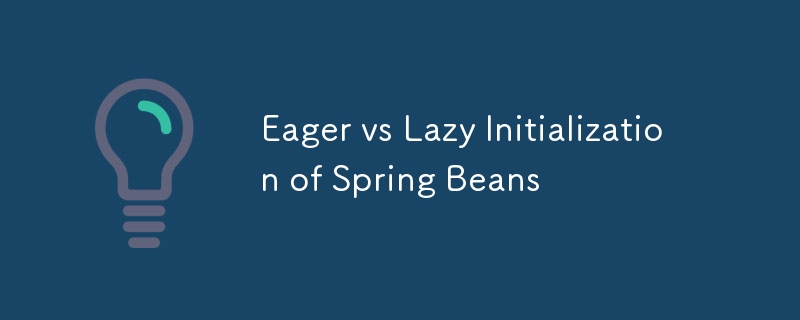
In Spring, one of the fundamental concepts revolves around the initialization of beans. When developing applications using the Spring Framework, you have the option to choose betweeneagerandlazyinitialization of beans. Both have their unique advantages and trade-offs, and understanding these differences can help you optimize your application’s performance and resource usage.
Before diving into eager and lazy initialization, let’s briefly touch on what Spring beans are. In Spring, a bean is simply an object that is instantiated, assembled, and managed by the Spring IoC (Inversion of Control) container. Beans are typically singleton by default (though this can be changed) and represent the core building blocks of a Spring application.
Eager initialization is the default behavior in Spring. When Spring’s ApplicationContext is created, it eagerly instantiates all beans defined in the configuration. This means that as soon as the Spring context is fully loaded, all singleton beans are created and their dependencies are injected.
Consider the following example:
@Configuration public class AppConfig { @Bean public ServiceA serviceA() { return new ServiceA(); } @Bean public ServiceB serviceB() { return new ServiceB(); } }
In the above code, both ServiceA and ServiceB will be instantiated as soon as the ApplicationContext is initialized. This is eager initialization in action.
Early Failure Detection: Since all beans are instantiated at startup, any issues such as misconfigurations, missing dependencies, or failures in bean creation are detected immediately. This makes it easier to identify and resolve issues during development.
Predictable Startup Behavior: With eager initialization, the startup process is predictable because all beans are created in advance, ensuring that they are ready for use as soon as the application starts.
Increased Startup Time: If your application has many beans and dependencies, eager initialization can increase the application’s startup time as all beans are created at once, regardless of whether they are immediately required or not.
Memory Usage: Eager initialization may lead to higher memory consumption, especially for beans that are not immediately used. All beans occupy memory as soon as the application context is initialized, which could be wasteful in certain scenarios.
Lazy initialization, as the name suggests, defers the creation of beans until they are first requested by the application. This means that a bean is only instantiated when it is accessed, either by another bean or by the application logic.
In Spring, lazy initialization can be enabled by annotating individual beans with @Lazy or by globally setting lazy initialization for all beans.
Here’s how you can implement lazy initialization:
@Configuration public class AppConfig { @Bean @Lazy public ServiceA serviceA() { return new ServiceA(); } @Bean public ServiceB serviceB() { return new ServiceB(); } }
In this example, ServiceA will not be instantiated until it is first accessed, whereas ServiceB will be eagerly initialized as usual.
Reduced Startup Time: Since beans are only instantiated when needed, the application’s startup time can be significantly reduced, especially in applications with many beans or complex initialization logic.
Memory Efficiency: Beans that are not immediately used do not consume memory resources, which can be beneficial in resource-constrained environments or when certain beans are only used in rare cases.
Delayed Failure Detection: If there are issues with the configuration or creation of a lazily initialized bean, those issues will not be detected until the bean is first accessed. This can delay the discovery of problems and make debugging more difficult.
Unexpected Delays During Runtime: Since lazy beans are instantiated upon their first use, the first request to a bean may introduce a delay in the application, especially if the initialization process is complex or time-consuming.
In Spring Boot, you can globally enable lazy initialization by adding the following property in the application.properties or application.yml file:
spring.main.lazy-initialization=true
When this is set, all beans in the application will be lazily initialized by default. This approach can be useful for applications with large numbers of beans that are not required immediately at startup.
Applications with Predictable Startup Requirements: If your application relies on having all beans ready immediately after startup and you want to detect configuration issues as early as possible, eager initialization is the better choice.
Small Applications: For small to medium-sized applications with a limited number of beans, the overhead of eager initialization is negligible, making it a more straightforward and predictable option.
Large Applications with Many Beans: In large applications where certain beans are rarely or never used in specific environments (e.g., certain beans are only needed for particular jobs or services), lazy initialization can optimize memory usage and improve startup times.
Performance-Sensitive Applications: If reducing startup time is a priority (for instance, in microservices where instances are frequently restarted), lazy initialization can be helpful in spreading the bean initialization load over time.
Conditional Use: If some beans are only used under specific conditions, lazy initialization can prevent unnecessary instantiation of those beans.
Choosing between eager and lazy initialization depends on your application’s needs. Eager initialization is beneficial for catching issues early and ensuring that all beans are ready immediately after startup. Lazy initialization, on the other hand, can optimize startup time and memory usage, but it may delay the detection of bean-related issues until the bean is first accessed.
By carefully considering the trade-offs, you can choose the right strategy or even mix both approaches to suit your application's specific requirements. Whether you choose eager or lazy initialization, understanding these concepts will help you optimize your Spring application and ensure that it behaves efficiently and predictably.
以上是Eager vs Lazy Initialization of Spring Beans的详细内容。更多信息请关注PHP中文网其他相关文章!




